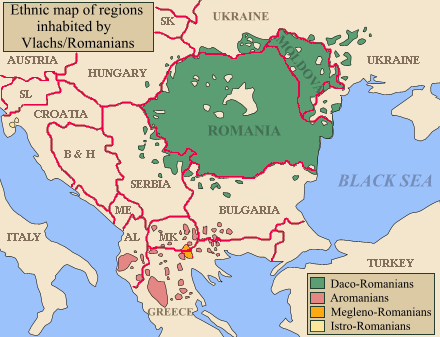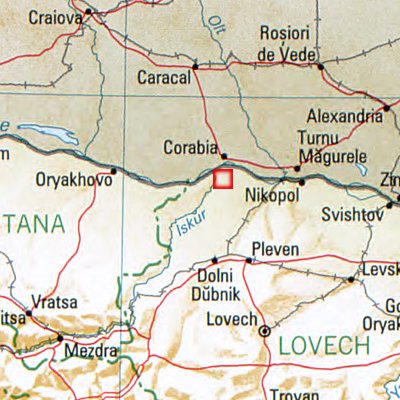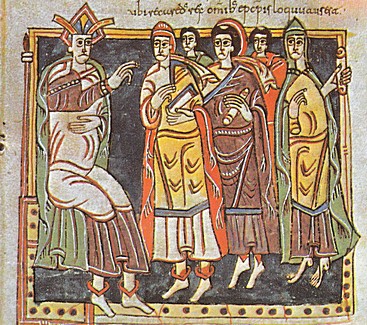|
586 AD
__NOTOC__ Year 586 ( DLXXXVI) was a common year starting on Tuesday of the Julian calendar. The denomination 586 for this year has been used since the early medieval period, when the Anno Domini calendar era became the prevalent method in Europe for naming years. Events By place Byzantine Empire * Spring – Emperor Maurice rejects a peace proposal of the Persians, in exchange for renewed payments in gold. * Battle of Solachon: A Byzantine army under command of Philippicus defeats the Sassanid Persians, near Dara. * The Avars besiege Thessalonica (Central Macedonia), the second city of the Byzantine Empire.History of the Byzantine Empire from DCCXVI to MLVII, George Finlay, p. 316 * The Vlachs are first mentioned in a Byzantine chronicle (approximate date). Europe * April 21 – King Liuvigild dies at Toledo after an 18-year reign, and is succeeded by his second son Reccared I. * Slavs advance to the gates of Thessaloniki and the Peloponnese. * Avars des ... [...More Info...] [...Related Items...] OR: [Wikipedia] [Google] [Baidu] |
Byzantine Empire
The Byzantine Empire, also known as the Eastern Roman Empire, was the continuation of the Roman Empire centred on Constantinople during late antiquity and the Middle Ages. Having survived History of the Roman Empire, the events that caused the fall of the Western Roman Empire in the 5th centuryAD, it endured until the fall of Constantinople to the Ottoman Empire in 1453. The term 'Byzantine Empire' was coined only after its demise; its citizens used the term 'Roman Empire' and called themselves 'Romans'. During the early centuries of the Roman Empire, the western provinces were Romanization (cultural), Latinised, but the eastern parts kept their Hellenistic culture. Constantine the Great, Constantine I () legalised Christianity and moved the capital to Constantinople. Theodosius I, Theodosius I () made Christianity the state religion and Greek gradually replaced Latin for official use. The empire adopted a defensive strategy and, throughout its remaining history, expe ... [...More Info...] [...Related Items...] OR: [Wikipedia] [Google] [Baidu] |
Rabbula Gospels
The Rabbula Gospels, or Rabula Gospels (Florence, Biblioteca Medicea Laurenziana, cod. Plut. I, 56), is a 6th-century illuminated Syriac Gospel Book. One of the finest Byzantine works produced in West Asia, and one of the earliest Christian manuscripts with large miniatures, it is distinguished by the miniaturist's predilection for bright colours, movement, drama, and expressionism. Created during a period from which little art survived, it nevertheless saw great development in Christian iconography. The manuscript has a significant place in art history, and is very often referred to. Recent scholarship has suggested that the manuscript, completed in 586 AD, was later partly overpainted by restorers and bound together with miniatures from other sources in the 15th or 16th century. Description The Gospel was completed in 586 at Monastery of St. John of Zagba (Syriac: , ), which, although traditionally thought to have been in Northern Mesopotamia, is now thought to have been i ... [...More Info...] [...Related Items...] OR: [Wikipedia] [Google] [Baidu] |
Crucifixion Of Jesus
The crucifixion of Jesus was the death of Jesus by being crucifixion, nailed to a cross.The instrument of Jesus' crucifixion, instrument of crucifixion is taken to be an upright wooden beam to which was added a transverse wooden beam, thus forming a "cruciform" or T-shaped structure. It occurred in 1st-century Roman Judaea, Judaea, most likely in AD 30 or AD 33. The event is described in the four canonical gospels, referred to in the New Testament epistles, and later attested to by #Other accounts and references, other ancient sources. Scholars nearly universally accept the Historicity of Jesus, historicity of Jesus's crucifixion, although there is no consensus on the details.Christopher M. Tuckett in ''The Cambridge companion to Jesus'' edited by Markus N. A. Bockmuehl 2001 Cambridge Univ Press pp. 123–124 According to the canonical gospels, Jesus was Arrest of Jesus, arrested and Sanhedrin trial of Jesus, tried by the Sanhedrin, and then Pilate's court, sentenced by ... [...More Info...] [...Related Items...] OR: [Wikipedia] [Google] [Baidu] |
Ratiaria
Ratiaria (or: Ratsaria, Raetiaria, Retiaria, Reciaria, Razaria; ; ;) was a city founded by the Moesians, a Daco- Thracian tribe, in the 4th century BC, along the river Danube. In Roman times it was named '' Colonia Ulpia Traiana Ratiaria''. It is located 2 km west of the present village of Archar in Vidin Province, northwestern Bulgaria and 3 km east of the present Balta Neagră Natural Reserve in southern Romania. The closest modern cities are Vidin (27 km to the north west), Lom (28 km to the east) in Bulgaria and Calafat (41 km to the north) in Romania. An archaeological museum for the site has recently been established in Dimovo. History Ratiaria was conquered by the Dacians of Burebista and later by the Romans. There was a gold mine in the city, which was exploited by the Thracians. The city may have owed its success to the goldsmiths. The earliest involvement of the Romans occurred in 75 BC when Gaius Scribonius Curio, prefect of Macedonia, ... [...More Info...] [...Related Items...] OR: [Wikipedia] [Google] [Baidu] |
Colonia Ulpia Oescus
Oescus, Palatiolon or Palatiolum (, ) was an important ancient city on the Danube river in Roman Moesia. It later became known as ''Ulpia Oescus''. It lay northwest of the modern Bulgarian city of Pleven, near the village of Gigen. For a short time it was linked by the longest and most famous stone bridge across the Danube, Constantine's Bridge, with the ancient city of Sucidava (modern-day Corabia, Romania). The city seems to have at one point reached a area of 280,000 m2 and a population of 100,000. Archaeological excavations have brought to light parts of the ancient city and are continuing. Etymology The name of the Roman town comes from the river Oescus (today Iskar). It probably meant "water" in the local Thracian dialect. History The Greek geographer Claudius Ptolemy (ca. 90–168 AD) described Ulpia Oescus as a city of the Triballi, an independent ancient tribe which inhabited today’s northwestern Bulgaria. Under Roman rule, Oescus began as an impor ... [...More Info...] [...Related Items...] OR: [Wikipedia] [Google] [Baidu] |
Danubian Limes
The Danubian Limes (), or Danube Limes, refers to the Roman military frontier or '' limes'' which lies along the River Danube in the present-day German state of Bavaria, in Austria, Slovakia, Hungary, Croatia, Serbia, Bulgaria and Romania. The Danube was not always or everywhere used by the Romans as the military frontier which was moved north or south in some locations according to military conquests, but it was maintained in many places as a fairly permanent defensive structure for long periods. The border was reinforced with numerous watchtowers, legion camps (''castra'') and forts (''castella''). Due to the boggy and dendritic nature of the Danube's river banks no border ramparts were built, unlike the Neckar-Odenwald Limes in Germany. The camps were built in the mid-1st century. Later, under Trajan, the camps, which had originally only been surrounded by earthen embankments, were enclosed by stone walls. A Roman road, the Danube Way () was laid along the ''limes'', which ... [...More Info...] [...Related Items...] OR: [Wikipedia] [Google] [Baidu] |
Pannonian Avars
The Pannonian Avars ( ) were an alliance of several groups of Eurasian nomads of various origins. The peoples were also known as the Obri in the chronicles of the Rus' people, Rus, the Abaroi or Varchonitai (), or Pseudo-Avars in Byzantine Empire, Byzantine sources, and the Apar () to the Göktürks. They established the Avar Khaganate, which spanned the Pannonian Basin and considerable areas of Central Europe, Central and Eastern Europe from the late 6th to the early 9th century. The name Pannonian Avars (after the area in which they settled) is used to distinguish them from the Avars (Caucasus), Avars of the Caucasus, a separate people with whom the Pannonian Avars may or may not have had links. Although the name ''Avar'' first appeared in the mid-5th century, the Pannonian Avars entered the historical scene in the mid-6th century, on the Pontic–Caspian steppe as a people who wished to escape the rule of the Göktürks. They are probably best known for their invasions and de ... [...More Info...] [...Related Items...] OR: [Wikipedia] [Google] [Baidu] |
Peloponnese
The Peloponnese ( ), Peloponnesus ( ; , ) or Morea (; ) is a peninsula and geographic region in Southern Greece, and the southernmost region of the Balkans. It is connected to the central part of the country by the Isthmus of Corinth land bridge which separates the Gulf of Corinth from the Saronic Gulf. From the late Middle Ages until the 19th century, the peninsula was known as the Morea, a name still in colloquial use in its demotic form. The peninsula is divided among three administrative regions: most belongs to the Peloponnese region, with smaller parts belonging to the West Greece and Attica regions. Geography The Peloponnese is a peninsula located at the southern tip of the mainland, in area, and constitutes the southernmost part of mainland Greece. It is connected to the mainland by the Isthmus of Corinth, where the Corinth Canal was constructed in 1893. However, it is also connected to the mainland by several bridges across the canal, including two submers ... [...More Info...] [...Related Items...] OR: [Wikipedia] [Google] [Baidu] |
Slavs
The Slavs or Slavic people are groups of people who speak Slavic languages. Slavs are geographically distributed throughout the northern parts of Eurasia; they predominantly inhabit Central Europe, Eastern Europe, Southeastern Europe, and Northern Asia, though there is a large Slavic minority scattered across the Baltic states and Central Asia, and a substantial Slavic diaspora in the Americas, Western Europe, and Northern Europe. Early Slavs lived during the Migration Period and the Early Middle Ages (approximately from the 5th to the 10th century AD), and came to control large parts of Central, Eastern, and Southeast Europe between the sixth and seventh centuries. Beginning in the 7th century, they were gradually Christianized. By the 12th century, they formed the core population of a number of medieval Christian states: East Slavs in the Kievan Rus', South Slavs in the Bulgarian Empire, the Principality of Serbia, the Duchy of Croatia and the Banate of B ... [...More Info...] [...Related Items...] OR: [Wikipedia] [Google] [Baidu] |
Reccared I
Reccared I (or Recared; ; ; 559 – December 601; reigned 586–601) was the king of the Visigoths, ruling in Hispania, Gallaecia and Septimania. His reign marked a climactic shift in history, with the king's renunciation of Arianism in favour of Nicene Christianity in 587. Reign Reccared was the younger son of King Leovigild by his first wife. Like his father, Reccared had his capital at Toledo. The Visigothic kings and nobles were traditionally Arian Christians, while the Hispano-Roman population were Chalcedonian Christians. The bishop Leander of Seville was instrumental in converting the elder son and heir of Leovigild, Hermenegild, to Chalcedonianism. Leander supported his rebellion and was exiled for his role. When King Leovigild died, within a few weeks of April 21, 586, bishop Leander was swift to return to Toledo. The new king had been associated with his father in ruling the kingdom and was acclaimed king by the Visigothic nobles without opposition. In January 5 ... [...More Info...] [...Related Items...] OR: [Wikipedia] [Google] [Baidu] |
Toledo, Spain
Toledo ( ; ) is a city and Municipalities of Spain, municipality of Spain, the capital of the province of Toledo and the ''de jure'' seat of the government and parliament of the autonomous communities of Spain, autonomous community of Castilla–La Mancha. Toledo is primarily located on the right (north) bank of the Tagus in central Iberian Peninsula, Iberia, nestled in a bend of the river. Built on a previous Carpetanian settlement, Toledo developed into an important Roman city of Hispania, later becoming the capital (''civitas regia'') of the Visigothic Kingdom and seat of a Roman Catholic Archdiocese of Toledo, powerful archdiocese. Often unsubmissive to Emirate of Córdoba, Umayyad central rule during the Islamic period, Toledo (طليطلة) nonetheless acquired a status as a major cultural centre (promoting productive cultural exchanges between the Ummah and the Latin Christendom), which still retained after the Fitna of al-Andalus, collapse of the caliphate and the crea ... [...More Info...] [...Related Items...] OR: [Wikipedia] [Google] [Baidu] |








